Thanks for all the love last week on my article about the premiere of KNOWN UNIVERSE. I’ve never seen such a positive talkback – it felt like some Bizzaro Universe AICN. Given that, if I have the time, and as long as I have something to say, I think I’ll try to write an article about what it was like to make each week’s episode.
LAST WEEK: Surviving Outer Space
First up: reaction to the last episode. I’ve spent half a lifetime doing research, and I think I have made some real contributions to our understanding of the universe. And what gets me into Time? An article titled: Everybody Poops: How Do Astronauts Go to the Bathroom in Space. Ahh, but I give up complaining. People love that damn orbital outhouse. Proof that, yes, we really are just fancy monkeys.
As you can tell by Mike’s statement in the episode – I really was not enthusiastic about sitting on the space toilet. And while I’d like to think my retort, “People are knocking on the door!” was evidence of a devastating wit, it wasn’t – it was actually the truth! That is a functional bathroom at NASA! There is an Earth toilet right behind the cameraman. And the space throne is fully functional – astronauts have to really practice on that thing. The one I was sitting on – the one with the camera – isn’t functional as far as, um, waste disposal, goes. It is what they call the positional trainer. Yes, potty re-training for astronauts. You train sitting on that one until you know how to position yourself without the camera. There is no ass camera in space.
The other segment I was in was one comparing my mile time on Earth and on a reduced-gravity treadmill. There is a fundamental truth that the segment gets right: it is much easier to work against the moon’s gravity. But I think it got some of the details wrong – you probably can’t run faster on the real moon. I wish the editors had left in my caveats about how that test isn’t really fair. An astrophysicist friend of mine, Todd Henry, who has run 21 marathons, has looked into it. He’s run out of novel places to do marathons on Earth, having done them on all 7 continents, so now he’s looking into the moon! For running fast, frequent strides are better than longer ones. On the moon you’d spend so much time in the air that you’d actually run slower. And the inflatable-pants treadmill wasn’t a perfect analog for the moon because the tread was just zooming by under my feet while I was floating. Still, it was fun to do, and it got the point across. As is so often the case, television isn’t the best medium for nuance.
Yes I look particularly out of shape in the Earth-bound segments. All I can say is – acting! I wasn’t actually going all out for my best time. And I really had to run much farther than a mile, because I had to do aspects of it many times while they got close-ups, tracking shots, etc. And of course they chose shots that made me look slow, like ones shot by a camera man on a cart moving along with me. Sometimes you have to put your pride aside to serve the narrative if you want to make good TV. Still, I did really run a timed mile (after the preliminary running), and let’s just say that level of acting was in my range – I couldn’t have done much better had I really gone all out.
THIS WEEK: Treasure Hunt
Treasure on Earth generally consists of rare, valuable things. But a surprising amount of it is tied to astronomy. For example, diamonds require the tremendous pressure of the Earth to turn carbon into a crystalline form. And metal mining can happen in some places, like Sudbury, Ontario, Canada, because a meteor impact long ago melted the surface of the Earth at the impact site, causing liquefied metal to seep into the cracks. Certain metals are very hard to mine on Earth, but are easy to get to on asteroids – hunks of metals left over from the formation of the solar system. If we could capture and mine an asteroid, it could result in trillions of dollars of astro-booty. That’s harder than it looks though, because you could actually run and jump off the surface of most asteroids. Mining would be quite difficult.
But there’s more: treasure in space also consists of rare, valuable things, but our definition of rare and valuable is different there. Things like water and fuel become treasures, because you have to take it with you, and every pound you lift into orbit is expensive. So it is much better to find your water and fuel in space if you can.
UNDER PRESSURE
To demonstrate how pressure can turn carbon into diamond, I got to do one of my favorite demos of the whole series: walking on water. Now I am no deity, so I had to use a trick – physics! We created a mixture of cornstarch and water, called oobleck (from the Dr. Seuss book Bartholomew and the Oobleck). This stuff is strange and awesome. It is a liquid under normal conditions, but if you put pressure on it, it becomes a sold. Now, when most people do this experiment they fill up a small child’s pool with this stuff. But to hell with that – we ain’t makin’ no YouTube video, we’re making a TV show! So we got a cement mixer, churned up two tons of the stuff, and poured it in a dumpster. The effects crew even built platforms on either side of the dumpster for me to stand on, had a crane ready to pull me out if anything went wrong, and set up a camera on a jib to capture the spectacle of a post-Newtonian astrophysicist prancing on a non-Newtonian fluid.
And it worked!
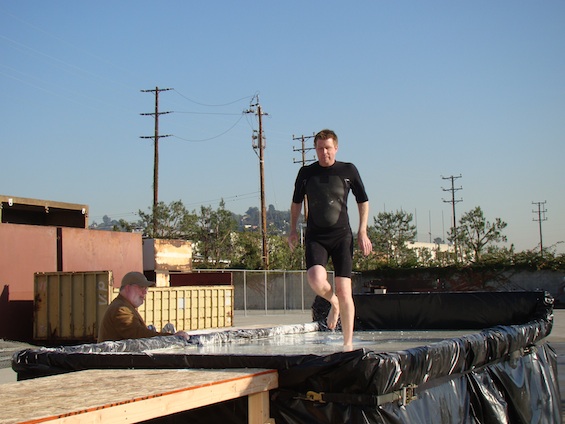
I was even able to dance in place on the stuff.
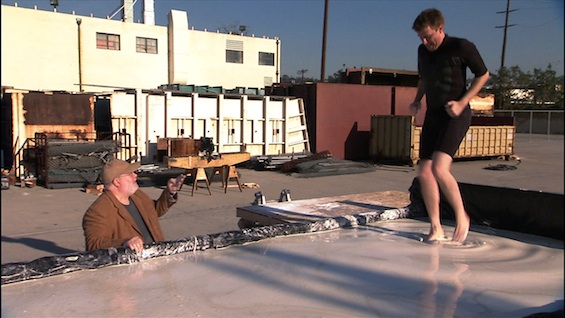
But to complete the experiment, I had to prove that it really acts like a liquid and stop running, allowing myself to sink.
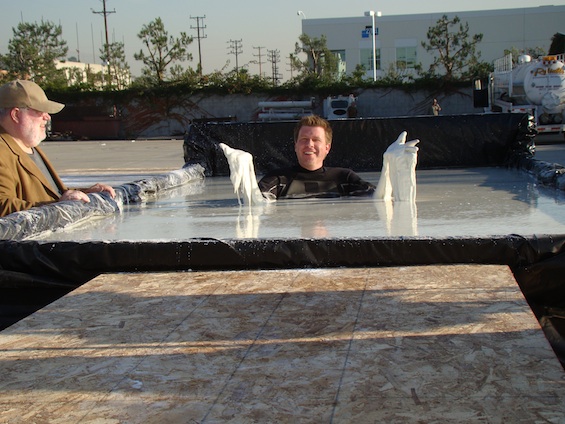
Let me tell you, taking an oobleck bath is very, very strange. For one thing, my feet were bent into a strange position beneath me, and this stuff is so thick, I couldn’t rearrange them to balance. And I was slowly sinking. This stuff is like quicksand. We finally did get all the shots we needed, and they got the crane to pull me out.
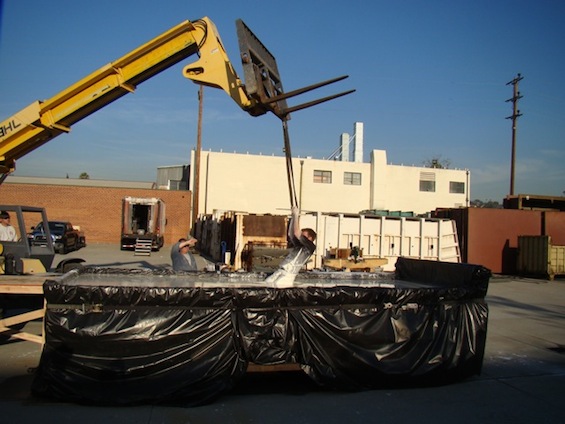
There was just one problem: the harder you pull on this stuff, the harder it pulls back on you. So the crane actually couldn’t pull me out! Or more accurately, I couldn’t hold on with one force pulling me one way, and another the other way. So the only way for me to get out was to creep out, inching my way very slowly. It took about five minutes. Notice the boom mic, because obviously I couldn’t wear a mic in this stuff.
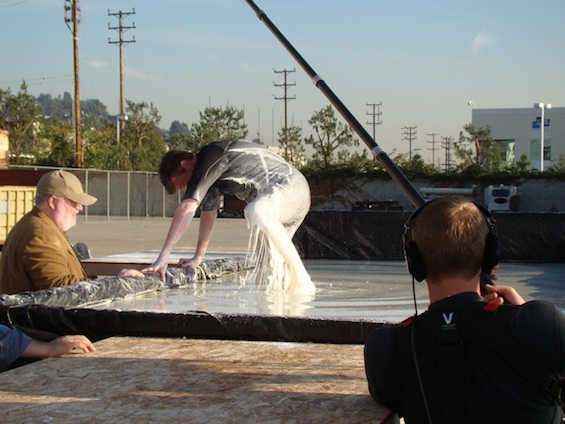
And here is the finished segment:
THE UNIVERSE VS CANADA
It is often hard to extract metals from the Earth because they are buried, they sank to the center when the Earth was molten, or because they are not concentrated enough to make mining profitable. But an asteroid impact 2 billion years ago in Sudbury changed all that. Now they can mine gold there because the impact melted the Earth, liquefying metal, allowing it to collect in the cracks in the shattered Earth. To demonstrate this, Mike Massimino and Steve “Jake” Jacobs got to use a powerful air gun to smash a cannonball (the asteroid) into a block of ice (Canada). Luckily, I was on set that day to film something else, and I got to watch.
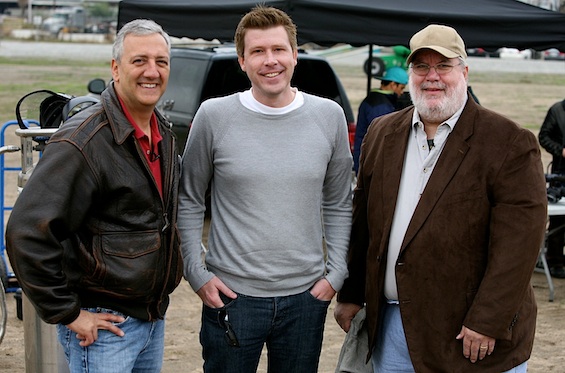

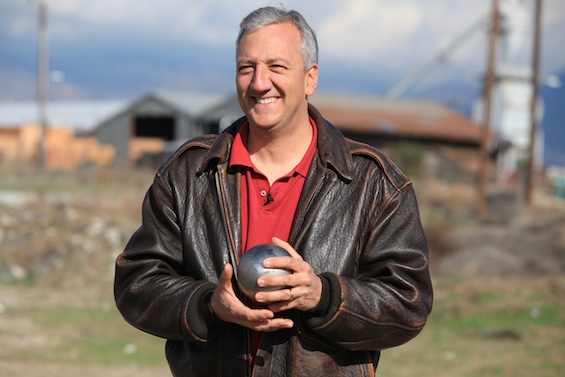
Yes, Mike is like some kind of space pirate, holding a cannonball there. He loaded it into the air cannon (still can’t believe we get to shoot freaking cannons!), and BOOM!
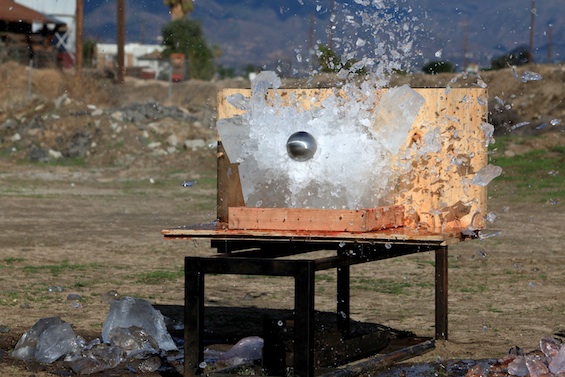
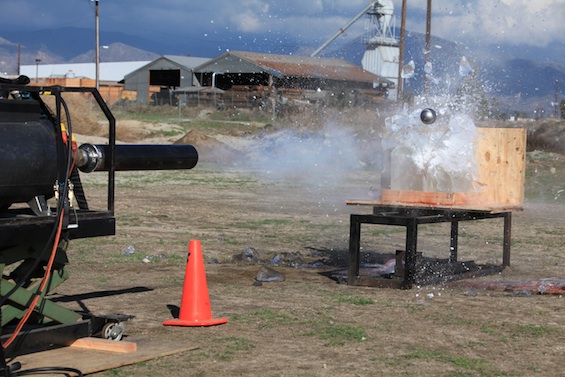
These images are spectacular, captured again in stills by Katrina Marcinowski.
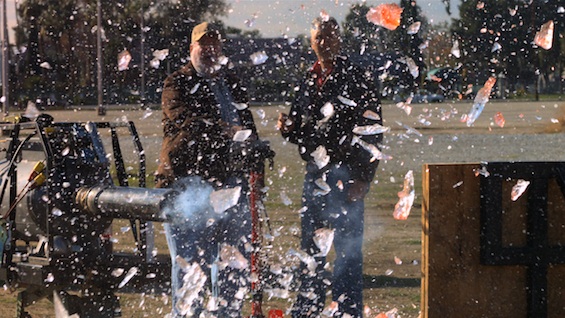
I think the above is a frame out of the high speed camera though. The slow motion footage is awesome. Here’s the segment:
So I think the episode turned out well – it mixes crazy demos, astronomy, space exploration, and even centers around the down-to-earth subject of a hunt for treasure. Incidentally, Harry’s geek sign is Treasure Hunter. Check it out this Thursday at 9 pm Eastern on the National Geographic Channel.
- Andy Howell aka Copernicus
